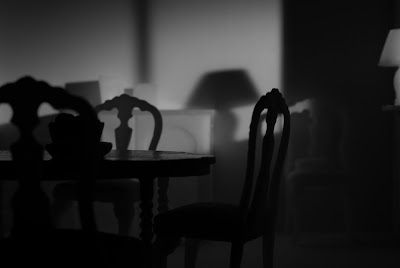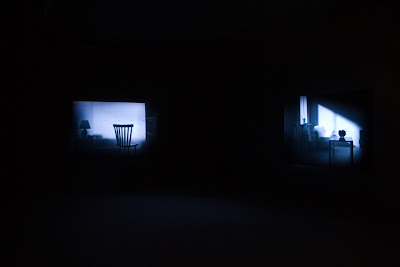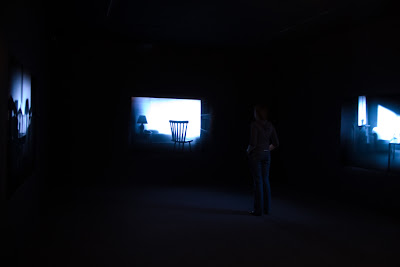
There is a dark corridor, with just one passage through some light coming from the half-open door to a production room. The corridor is not long, so before I know it, I'm in a black room. There is apparently no light, except for three large, very, very dimly lit images. Actually, they seem more like windows, as what we see on them are interiors - at first glance it is hard to tell whether those are three rooms, or the same one. The rooms have a sensual, soft light, and everything about them seems dream-like.

That is a very comfortable place to be, delightfully melancholy, hidden in the middle, looking out into the private zone, the excessively private zone of what might have been a perfectly regular set of spaces, were they not so hypnotically absent.

If there is something at once appealing and haunting in this triple view, I am reminded that there was a TV set in the entrance. I go back, and the curator Katarzyna Krysiak tells me that although the video is an hour-long loop, it will start again soon and is worth watching at least the first minutes.
So I put myself comfortable. And the same room I saw on one (two?) of the pictures appears. And then, it starts melting. First, the back of the chair thins to nothing, and it falls apart. Then, progressively, the lamp gives way, the bookshelf (how could I have not noticed it before?), the table, the bed... The whole wax model (as it turns out) vanishes bit by bit.
According to the curator, this is the artists reaction to a friend's depression. It is inspired by how a physical space changes in such circumstances.
Johan Dahlberg is a master of disguise. But his masquerades are not about people. Rather, Dahlberg masks space. In his work (check out his site for several other interesting examples), illusion is the basis for questioning our relation with the space we see and feel. It comes as no surprise that among his favorite tools are models of rooms (their doppelgängers) and surveillance equipment. But contrary to many commentators, I have some doubts whether we can define Dahlberg's work through the prism of the "Big Brother" universe. There is so much more in his observing of our observing of an object! Be it with cameras and screens, be it through the nomenclature of surveillance and false spaces. But see, for example, this work from 2000, (Untitled) Billboard,presented in the Swedish town of Uddevalla:


The wonderful quality I find in these works is their capacity to confuse our sense of space, and question the order we assume as self-comprehensive. How mine is this space? Where am I in relation to it? And how sure can I be of it, of what it is?
The exhibition I visited at the Foksal Gallery (on until January 11) is part of an entire cycle called Quiet Home. What is the degree of irony in such a title? That depends on where you find yourself in relation to it, doesn't it?
The pictures from the exhibition courtesy of the Foksal Gallery.
Photos of Untitled (Billboard): copyright Jonas Dahlberg.

Tidak ada komentar:
Posting Komentar